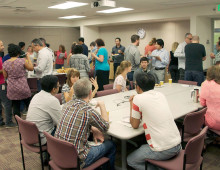Genomic regions containing two-thirds of all annotated barley genes have been sequenced. The Science: Researchers generated nearly 16,000 sequences of gene-containing regions for barley, mapping approximately two-thirds of all annotated barley genes. The Impact: While researchers continue to work on a complete reference sequence for the barley genome, the determination of improved sequence assemblies for…
Diversity & Inclusion Socials: Fostering Workplace Culture Change over Coffee and Conversation
To encourage employee interactions among DOE JGI staff–who reside in three different buildings— the Diversity & Inclusion Working Group launched the first monthly Coffee Social in August, 2015. The events are organized by the Working Group, but different groups within the DOE JGI take on the hosting duties at each gathering over the course of the year. These…
Seeking “Gold Standard” Wastewater Treatments
Metagenomic analyses lend insights into how microbes break down wastewater contaminants. The Science: Researchers conducted analyses of microbial communities in laboratory-scale bioreactors breaking down contaminated wastewater from gold ore processing. The Impact: In this “first application of genome-resolved metagenomics” to characterize bioreactors involved in gold ore processing, the data reveal how the bioreactors utilize available…
Sullivan on VirSorter in WIRED
Sequencing all the DNA in a sample is pretty straightforward—except then you have to sort out the DNA. “It’s almost like you took hundreds of different puzzles and threw all the pieces together,” says Tanja Woyke, a microbiologist at the DOE Joint Genome Institute and project contributor. “Now you have to put those puzzles together and figure…
DOE JGI Interns Share Their Summer Experiences
In 2015, the JGI hosted 10 interns who spent the summer crunching genomic data at a computer, working at the lab bench, and even spending time out in the field.
First Public Resource for Secondary Metabolites Searches
IMG-ABC allows researchers to link sequencing data and the search for novel biosynthetic gene pathways. The Science: The wealth of genomic and metagenomic datasets for microbes, particularly from previously unstudied environments, within the Integrated Microbial Genomes (IMG) system is being applied in a new public database to the search for novel secondary metabolites that could…
Keeping Algae from Stressing Out
Identifying pathways in algae that produce oil without killing them While most people might know some algae as “pond scum,” to the U.S. Department of Energy (DOE), they are tiny organisms that could provide a source of sustainable fuels. Like plants, they can convert light into energy-rich chemical compounds; unlike plants, they require less space…
2015 Call for ETOP Letters of Intent
1. INTRODUCTION The University of California, Lawrence Berkeley National Laboratory (“University” or “LBNL”) is soliciting Letters of Intent for the Department of Energy Joint Genome Institute (DOE JGI) Emerging Technologies Opportunity Program (ETOP) 2015 award. This is a solicitation for Letters of Intent to participate in the ETOP. This announcement constitutes the only solicitation. The University…
Cataloging small RNAs in switchgrass
Cultivated grasses are the most abundant sustainable class of biomass that can be produced in the United States, and one of the Department of Energy’s candidate bioenergy feedstock crops is switchgrass. MicroRNAs (miRNAs) are important regulatory molecules of vegetative development and stress response, though their specific roles in switchgrass and in bioenergy crop diversity in general…
Sequencing aquatic fungi
Aquatic fungi perform several important functions in natural ecosystems. Similar to terrestrial fungi, their predominant role is the decomposition of organic carbon. In freshwater streams, fungi are most efficient in transforming leaf-litter energy into biomass. Aquatic fungi are also capable of degrading manmade pollutants such as DDT, and sequestering metals such as cadmium. Despite being…





